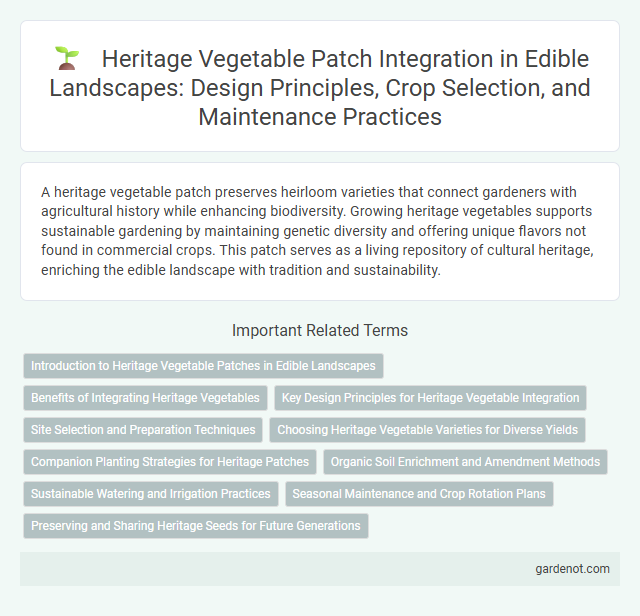A heritage vegetable patch preserves heirloom varieties that connect gardeners with agricultural history while enhancing biodiversity. Growing heritage vegetables supports sustainable gardening by maintaining genetic diversity and offering unique flavors not found in commercial crops. This patch serves as a living repository of cultural heritage, enriching the edible landscape with tradition and sustainability.
Introduction to Heritage Vegetable Patches in Edible Landscapes
Heritage vegetable patches in edible landscapes preserve heirloom varieties that offer unique flavors and biodiversity. These patches support sustainable gardening by maintaining genetic diversity and connecting gardeners to agricultural history. Incorporating heritage vegetables enhances both ecological resilience and cultural heritage in homegrown food systems.
Benefits of Integrating Heritage Vegetables
Integrating heritage vegetables into an edible landscape enhances biodiversity by preserving rare and heirloom plant varieties that support pollinators and soil health. These vegetables often have superior flavor profiles, nutritional content, and resilience to local pests and diseases, reducing the need for chemical interventions. Cultivating heritage vegetable patches also strengthens cultural heritage and promotes sustainable gardening practices, fostering a deeper connection to traditional agriculture.
Key Design Principles for Heritage Vegetable Integration
Heritage vegetable integration in edible landscapes emphasizes preserving biodiversity by selecting heirloom varieties that thrive in local climates and soil conditions. Designing around crop rotation and companion planting enhances soil health and pest resistance, ensuring sustainable productivity. Incorporating traditional growing methods and aesthetic layouts highlights cultural heritage while promoting ecological balance.
Site Selection and Preparation Techniques
Selecting a well-drained, sunny site with nutrient-rich soil is crucial for establishing a thriving heritage vegetable patch in an edible landscape. Incorporating organic matter and performing soil tests to adjust pH levels ensures optimal growing conditions tailored to heirloom varieties. Raised beds or contouring techniques improve drainage and soil structure, enhancing root development and plant health.
Choosing Heritage Vegetable Varieties for Diverse Yields
Selecting heritage vegetable varieties ensures a diverse yield by incorporating plants adapted to local climates and soils, enhancing resilience and flavor profiles. Heritage seeds often possess unique genetic traits that promote disease resistance and varied maturation times, supporting continuous harvests. Cultivating these varieties preserves agricultural biodiversity while offering a rich spectrum of tastes and nutritional values in the edible landscape.
Companion Planting Strategies for Heritage Patches
Companion planting in heritage vegetable patches enhances pest control and soil fertility by pairing compatible plant species such as beans with corn or marigolds with tomatoes. Utilizing traditional herbs like basil alongside heirloom tomatoes can improve flavor and deter harmful insects naturally. Strategic diversity within the patch promotes ecological balance, reducing the need for synthetic pesticides and supporting sustainable edible landscapes.
Organic Soil Enrichment and Amendment Methods
Organic soil enrichment and amendment methods for heritage vegetable patches emphasize the use of compost, aged manure, and green manures to enhance soil fertility naturally. Incorporating biochar and mulching improves soil structure, moisture retention, and microbial activity essential for heritage crops. Crop rotation and cover cropping further replenish nutrients, reducing the need for synthetic fertilizers and supporting sustainable edible landscapes.
Sustainable Watering and Irrigation Practices
Heritage vegetable patches thrive with sustainable watering and irrigation practices, emphasizing water conservation and soil health. Techniques such as drip irrigation and rainwater harvesting minimize water waste and maintain consistent moisture levels suitable for heirloom varieties. Incorporating mulch and organic matter enhances soil retention, supporting resilient plant growth while reducing irrigation frequency.
Seasonal Maintenance and Crop Rotation Plans
Seasonal maintenance in a heritage vegetable patch ensures soil health and maximizes yield by timely weeding, mulching, and watering based on crop requirements and climate conditions. Crop rotation plans are vital to prevent nutrient depletion and reduce pest and disease buildup by alternating plant families such as legumes, root vegetables, and leafy greens each season. Implementing these practices promotes sustainable growth and preserves the genetic diversity of heirloom varieties in the edible landscape.
Preserving and Sharing Heritage Seeds for Future Generations
Heritage vegetable patches play a crucial role in preserving genetic diversity by cultivating rare and heirloom seed varieties passed down through generations. These seeds, rich in unique flavors and adaptability, contribute to food security and cultural heritage conservation. Sharing heritage seeds within communities encourages biodiversity and ensures the survival of traditional crops for future generations.
Heritage vegetable patch Infographic

 gardenot.com
gardenot.com